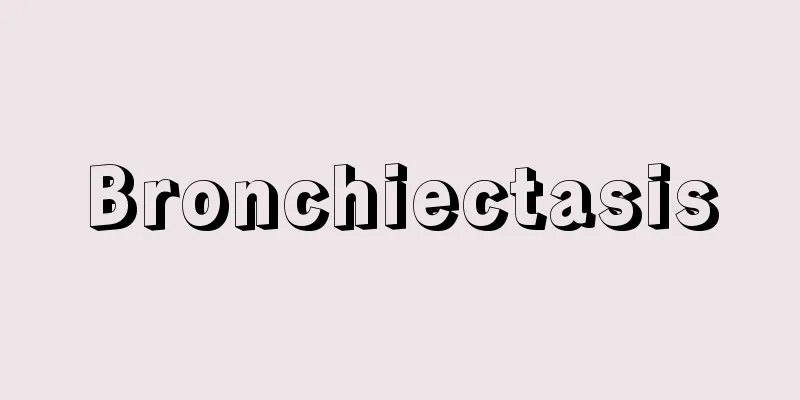Bronchiectasis

|
What kind of disease is it? ●Main symptoms and course This is a disease in which the inside of the bronchi expands. The expansion of the bronchi seen in this disease does not return to normal. The expansion area has a reduced ability to purify itself, making it easier for phlegm to accumulate, and symptoms similar to those of chronic bronchitis appear. Patients cough and produce phlegm, sometimes accompanied by bloody phlegm or hemoptysis. Large amounts of phlegm are produced, especially in the early morning. The phlegm that comes out with the cough is yellow to green in color. Adults are able to cough up phlegm on their own, but small children who are unable to cough up phlegm on their own may continue to expand the expansion of the expansion. Because the bronchial mucosa is inflamed, patients will suffer repeated respiratory infections and gradually develop respiratory failure if not treated properly. ● Causes of disease and how symptoms develop When the bronchi become abnormally dilated in certain areas, the purification function of the bronchi is reduced and phlegm tends to accumulate. Furthermore, bacteria and other organisms tend to multiply, making it easier to develop bronchitis or pneumonia. Also, blood vessels increase in the dilated areas. This causes bloody phlegm and hemoptysis. There are two causes: congenital and acquired. Congenital cases are caused by congenital abnormalities in the bronchi, such as primary ciliary dyskinesia, which causes bronchiectasis due to repeated airway infections. In this case, chronic sinusitis is often also present. In the case of acquired cases, if a child has had a severe respiratory infection such as pneumonia during infancy, the airways may be damaged, and repeated infections in that area may cause the bronchi to expand. In addition, it may occur following other diseases such as tuberculosis and atypical mycobacteria infection. EBM checks on common treatments and care [Treatment and care] Promotes phlegm excretion [Rating] ☆☆☆☆☆ [Evaluation Points] The effectiveness of promoting the discharge of phlegm through drugs and non-drug methods has been confirmed by highly reliable clinical studies. Non-drug methods include postural drainage, in which the patient tilts the body to make it easier to cough up phlegm, and chest percussion, in which the patient taps the chest to make it easier to cough up phlegm. These methods should be actively used, especially for young children who are unable to cough up phlegm on their own. (1)-(3) [Treatment and care] Use of antibiotics [Rating] ☆☆☆☆☆ [Evaluation points] In cases where an infectious disease occurs concomitantly, the use of macrolide antibiotics has been confirmed to be effective through highly reliable clinical studies. In addition, if symptoms worsen, other antibiotics may be used, and in cases where the condition becomes extremely severe, the patient may be hospitalized and given intravenous antibiotic infusions. (4) [Treatment and care] Use bronchodilators [Rating] ☆☆☆ [Evaluation Points] Clinical studies have confirmed the effectiveness of using bronchodilators when you have an asthma-like cough. (5)(6) [Treatment and care] Use hemostatic drugs [Rating] ☆☆☆ [Evaluation points] In cases where bloody sputum is present, the use of hemostatic drugs has been shown to be effective in clinical studies. (7) [Treatment and care] Perform bronchial artery embolization [Evaluation] ☆☆☆ [Evaluation points] If hemoptysis continues, a hemostatic drug is used, the artery involved in the bleeding is identified, and a catheter is inserted through the thigh to perform bronchial artery embolization, which blocks the blood vessel. The effectiveness of these procedures has been confirmed in clinical studies. (8)-(12) [Treatment and care] Perform bronchial resection [Rating] ☆☆☆ [Points to consider when evaluating] If the infection continues to recur, it is important to confirm that the lesion is only partial, and if lung function can be maintained after removal, bronchial resection may be performed. (8)-(12) Checking commonly used drugs with EBM Expectorant [Drug name] Mucosolvan (ambroxol hydrochloride) (13) [Rating] ☆☆☆☆ [Drug name] Mucodyne (Carbocisteine) (13) [Rating] ☆☆☆☆ [Evaluation points] Its effectiveness has been confirmed through reliable clinical research. Macrolide antibiotics [drug name] Erythromycin (14) [Rating] ☆☆☆☆☆ [Drug name] Clarithromycin (clarithromycin) (15) (16) [Rating] ☆☆☆☆ [Drug name] Rulid (roxithromycin) (17) [Rating] ☆☆☆☆☆ [Drug name] Zithromax (azithromycin hydrate) (18)-(20) [Rating] ☆☆☆☆ [Evaluation points] The effectiveness of all four of the macrolide antibiotics mentioned above has been confirmed through reliable clinical studies. Bronchodilator [Drug name] Theodur/Unicon/Unifil LA (theophylline sustained-release preparation) (5) [Rating] ☆☆☆ [Evaluation points] The effectiveness of this drug has been confirmed through clinical research. Antibiotics used during acute exacerbations (outpatient treatment) [Drug name] Cravit (levofloxacin hydrate) (21) (22) [Rating] ☆☆☆☆☆ [Drug name] Ciproxan (Ciprofloxacin hydrochloride) (21)(23)(24)(26) [Rating] ☆☆☆☆☆ [Drug name] Ozex/Tosuxacin (tosufloxacin tosilate hydrate) (21)(25) [Rating] ☆☆☆ [Drug name] Cefzon (Cefdinir) (21) (27) [Rating] ☆☆☆ [Drug name] Pansporin T (cefotiam hexetil hydrochloride) (21) (28) [Rating] ☆☆☆ [Evaluation points] Antibiotics are used if an infection occurs and symptoms such as high fever and severe coughing suddenly worsen. Select an antibiotic that is effective against the bacteria detected in the sputum culture test. The effectiveness of levofloxacin hydrate and ciprofloxacin hydrochloride has been confirmed by highly reliable clinical studies. The effectiveness of other drugs has also been confirmed by clinical studies. Antibiotics used during acute exacerbations (hospitalization) [Drug name] Zosyn (tazobactam sodium, piperacillin sodium) (29) (30) [Rating] ☆☆☆ [Drug name] Modacin (ceftazidime hydrate) (29) (30) [Rating] ☆☆☆ [Drug name] Sulperazone (cefoperazone sodium/sulbactam sodium combination drug) (29) (30) [Rating] ☆☆☆ [Drug name] Maxipime (cefepime hydrochloride hydrate) (29) (30) [Rating] ☆☆☆ [Drug name] Thienam (imipenem hydrate, cilastatin sodium) (29) (30) [Rating] ☆☆☆ [Drug name] Carbenin (combination of panipenem and betamipron) (29) (30) [Rating] ☆☆☆ [Drug name] Meropenem (meropenem hydrate) (29) (30) [Rating] ☆☆☆ [Drug name] Cravit (levofloxacin hydrate) (29) (30) [Rating] ☆☆☆ [Drug name] Ciproxan (Ciprofloxacin) (29) (30) [Rating] ☆☆☆ [Drug name] Azactam (Aztreonam) (29) (30) [Rating] ☆☆☆ [Evaluation points] If symptoms worsen to the point of respiratory failure, hospitalization and intravenous administration of antibiotics are required. The effectiveness of the above drugs has been confirmed through clinical studies. A hemostatic drug used when coughing up blood [drug name] Adona (carbazochrome sodium sulfonate hydrate) (7) [Rating] ☆☆☆ [Drug name] Tranexamic acid (7) [Rating] ☆☆☆ [Evaluation points] The effectiveness of both drugs has been confirmed through clinical studies. Overall, it is currently the most reliable treatment. <br /> Expelling phlegm is an effective treatment. The dilated bronchi seen in this disease are irreversible. The purification function of dilated bronchi is reduced, so phlegm tends to accumulate, creating an environment that is prone to infection. Repeated infections will cause the dilated areas to widen further, so preventing infection is extremely important. When phlegm accumulates, it blocks the airways, making breathing difficult and making you more susceptible to infections, so it is important to expel phlegm from the airways. Once you have mastered the techniques, postural drainage, which involves percussion on the chest and tilting the body to make it easier to expectorate phlegm, can be quite effective treatments. This is especially important for young children who are unable to expel phlegm on their own. Nebulizer inhalation using bronchodilators or drugs that promote the expulsion of phlegm (see Spacer and Nebulizer Inhalation) is also effective. Continue taking antibiotics even after symptoms have subsided. If an infection occurs, it is important to administer antibiotics that are effective against the causative bacteria, as confirmed by reliable clinical studies. Additionally, clinical studies have shown that taking small doses of macrolide antibiotics for 2 to 3 years after the acute infection has subsided reduces the risk of serious complications, such as decreased lung function and pneumonia. If the infection becomes severe, intravenous antibiotics will be administered. If the initial treatment for the infection is not effective and the infection becomes severe, intravenous antibiotics will be administered instead of oral antibiotics. If the infection becomes severe enough to cause persistent fever or respiratory failure, hospitalization will be required. Bronchodilators and hemostatic drugs are also effective It seems reasonable to use bronchodilators when you have an asthma-like cough, and hemostatic drugs when you have bloody sputum, to suppress the symptoms. Catheter therapy or surgery may be appropriate. If hemoptysis continues, a catheter may be inserted through the thigh to block the source of the bleeding (bronchial artery embolization). If the area of bronchiectasis is limited, the bronchi may be surgically removed. (1)Flude LJ, Agent P, Bilton D. Chest physiotherapy techniques in bronchiectasis. Clin Chest Med 2012; 33:351. Source: "EBM: A book that explains correct treatment" Information about the book "EBM: A book that explains correct treatment" |
|
どんな病気でしょうか? ●おもな症状と経過 気管支の内側が広がってしまう病気です。この病気でみられる気管支の拡張は元に戻ることはありません。拡張した部分は浄化作用が低下して痰(たん)がたまりやすくなり、慢性気管支炎と似た症状が現れます。せき、痰がでて、ときには血痰(けったん)や喀血(かっけつ)を伴うこともあります。とくに早朝に大量の痰がでます。せきと一緒にでる痰には黄色から緑色の色がついています。大人は自力で痰をだすことができますが、小さい子どもで、自分の力で痰をだせない場合にはさらに拡張部分が広がっていく可能性があります。気管支粘膜が炎症をおこしているため、呼吸器の感染症をなんどもくり返し、きちんと治療しないと徐々に呼吸不全になってしまいます。 ●病気の原因や症状がおこってくるしくみ 気管支が部分的に異常に広がり、そのために気管支の浄化作用が低下して痰がたまりやすくなります。さらに細菌などが繁殖しやすくなるため、気管支炎や肺炎を引きおこしやすくなります。また、拡張した部分には血管が増えます。これが血痰や喀血の原因となります。 原因には先天性と後天性の二つがあります。先天性のものは原発性線毛機能不全症候群(げんぱつせいせんもうきのうふぜんしょう)など気管支に生まれつきの異常があり、気道感染をくり返すために気管支拡張が生じるものです。この場合、しばしば慢性副鼻腔炎(ふくびくうえん)を合併します。 後天性のものでは、幼児期に肺炎など重症の呼吸器感染症にかかったことがあると、気道が傷つく場合があり、その部分で感染をくり返すと、気管支が拡張することがあります。ほかに結核や非定型抗酸菌症(ひていけいこうさんきんしょう)などの病気に引き続いて発生する場合があります。 よく行われている治療とケアをEBMでチェック [治療とケア]痰の排出を促進する [評価]☆☆☆☆☆ [評価のポイント] 薬や薬以外の方法で痰の排出を促進することは非常に信頼性の高い臨床研究によって効果が確認されています。薬以外の方法には体を傾けて痰をだしやすくする体位ドレナージ、胸を叩いて痰をだしやすくする胸部軽叩打法(きょうぶけいこうだほう)などがあります。とくに自力で痰をだせない幼児などでは積極的に行う必要があります。(1)~(3) [治療とケア]抗菌薬を用いる [評価]☆☆☆☆☆ [評価のポイント] 感染症を併発した場合、マクロライド系抗菌薬を使用することは非常に信頼性の高い臨床研究によって効果が確認されています。また、症状が悪化した場合にはほかの抗菌薬を用いたり、非常に重症化した場合には入院して抗菌薬の点滴静脈注射を行ったりします。(4) [治療とケア]気管支拡張薬を用いる [評価]☆☆☆ [評価のポイント] 喘息(ぜんそく)のようなせきがでる場合、気管支拡張薬を使用することは臨床研究によって効果が確認されています。(5)(6) [治療とケア]止血薬を使用する [評価]☆☆☆ [評価のポイント] 血痰を伴う場合、止血薬を使用することは臨床研究によって効果が確認されています。(7) [治療とケア]気管支動脈塞栓術(きかんしどうみゃくそくせんじゅつ)を行う [評価]☆☆☆ [評価のポイント] 喀血が続くときは、止血薬を使用し、出血にかかわっている動脈を探して、太(ふと)ももからカテーテルを挿入して、血管をふさぐ気管支動脈塞栓術を行う場合もあります。これらのことは臨床研究によって効果が確認されています。(8)~(12) [治療とケア]気管支の切除術を行う [評価]☆☆☆ [評価のポイント] 感染をなんどもくり返す場合には、病変が一部のみであることを確認し、切除後も肺機能を維持できるのであれば気管支の切除術を行うこともあります。(8)~(12) よく使われている薬をEBMでチェック 去痰薬(きょたんやく) [薬名]ムコソルバン(アンブロキソール塩酸塩)(13) [評価]☆☆☆☆ [薬名]ムコダイン(カルボシステイン)(13) [評価]☆☆☆☆ [評価のポイント] 信頼性の高い臨床研究によって効果が確認されています。 マクロライド系抗菌薬 [薬名]エリスロシン(エリスロマイシン)(14) [評価]☆☆☆☆☆ [薬名]クラリス/クラリシッド(クラリスロマイシン)(15)(16) [評価]☆☆☆☆ [薬名]ルリッド(ロキシスロマイシン)(17) [評価]☆☆☆☆☆ [薬名]ジスロマック(アジスロマイシン水和物)(18)~(20) [評価]☆☆☆☆ [評価のポイント] 上記4種類のマクロライド系抗菌薬は、いずれも信頼性の高い臨床研究によって効果が確認されています。 気管支拡張薬 [薬名]テオドール/ユニコン/ユニフィルLA(テオフィリン徐放剤)(5) [評価]☆☆☆ [評価のポイント] この薬は臨床研究によって効果が確認されています。 急性増悪(ぞうあく)時に使用する抗菌薬(外来治療) [薬名]クラビット(レボフロキサシン水和物)(21)(22) [評価]☆☆☆☆☆ [薬名]シプロキサン(塩酸シプロフロキサシン)(21)(23)(24)(26) [評価]☆☆☆☆☆ [薬名]オゼックス/トスキサシン(トスフロキサシントシル酸塩水和物)(21)(25) [評価]☆☆☆ [薬名]セフゾン(セフジニル)(21)(27) [評価]☆☆☆ [薬名]パンスポリンT(セフォチアムヘキセチル塩酸塩)(21)(28) [評価]☆☆☆ [評価のポイント] 感染症を併発し、高度な発熱、激しいせきなど症状が急激に悪化した場合は抗菌薬を用います。痰の培養検査で検出された細菌に効果のある抗菌薬を選択します。 レボフロキサシン水和物、塩酸シプロフロキサシンについては、非常に信頼性の高い臨床研究によって効果が確認されています。そのほかの薬についても、臨床研究によって効果が確認されています。 急性増悪時に使用する抗菌薬(入院治療) [薬名]ゾシン(タゾバクタムナトリウム・ピペラシリンナトリウム)(29)(30) [評価]☆☆☆ [薬名]モダシン(セフタジジム水和物)(29)(30) [評価]☆☆☆ [薬名]スルペラゾン(セフォペラゾンナトリウム・スルバクタムナトリウム配合剤)(29)(30) [評価]☆☆☆ [薬名]マキシピーム(セフェピム塩酸塩水和物)(29)(30) [評価]☆☆☆ [薬名]チエナム(イミペネム水和物・シラスタチンナトリウム)(29)(30) [評価]☆☆☆ [薬名]カルベニン(パニペネム・ベタミプロン配合剤)(29)(30) [評価]☆☆☆ [薬名]メロペン(メロペネム水和物)(29)(30) [評価]☆☆☆ [薬名]クラビット(レボフロキサシン水和物)(29)(30) [評価]☆☆☆ [薬名]シプロキサン(シプロフロキサシン)(29)(30) [評価]☆☆☆ [薬名]アザクタム(アズトレオナム)(29)(30) [評価]☆☆☆ [評価のポイント] 呼吸不全をおこすほど症状が悪化した場合には入院し、抗菌薬の点滴静脈注射が必要となります。上記の薬については、臨床研究によって効果が確認されています。 血痰時に使用する止血薬 [薬名]アドナ(カルバゾクロムスルホン酸ナトリウム水和物)(7) [評価]☆☆☆ [薬名]トランサミン(トラネキサム酸)(7) [評価]☆☆☆ [評価のポイント] いずれの薬も臨床研究によって効果が確認されています。 総合的に見て現在もっとも確かな治療法 痰の排出は有効な治療法 この病気でみられる気管支の拡張は元に戻らないものです。拡張した気管支では浄化作用が低下するため、痰がたまりやすく、感染をおこしやすい環境となります。感染をくり返すと拡張部分がさらに広がりますから、感染の予防は非常に大切です。 痰がたまっていると気道がふさがって呼吸が苦しくなるほか、感染もおこしやすくなります。そこで、気道から痰を排出することが大切です。 胸部の叩打や身体を傾けて痰をだしやすくする体位ドレナージは、コツを身につければかなり有効な治療法となります。 とくに自力で痰を排出できない幼い子どもでは積極的に行います。また、痰の排出を促す薬や気管支拡張薬を用いたネブライザー吸入(スペーサーとネブライザー吸入の項)も有効です。 抗菌薬は症状が落ち着いても継続 感染症を併発した場合は原因となる細菌に効果のある抗菌薬を投与することの重要性が、信頼性の高い臨床研究で確認されています。 また、急性期の感染症状が落ち着いてからも2~3年にわたってマクロライド系の抗菌薬を少量服用すると、肺機能の低下や肺炎などの重い合併症をきたす可能性が小さくなることが臨床研究によって示されています。 重症化したら抗菌薬の静脈注射も 感染症の初期の治療が効果を示さず、重症化した場合には、内服の抗菌薬ではなく、点滴静脈注射を行います。発熱が続いたり、呼吸不全をおこしたりするほど重症になれば入院治療が必要となります。 気管支拡張薬、止血薬も有効 喘息のようなせきがでるときは気管支拡張薬を使用し、血痰がでているときは止血薬を使用して、症状を抑えることも理にかなっていると思われます。 カテーテル治療や手術が適応のことも 喀血が続くときは太ももからカテーテルを挿入して、出血の原因箇所をふさぐ治療(気管支動脈塞栓術)を行うほか、気管支拡張部分が限られている場合は手術によって気管支を切除することもあります。 (1)Flude LJ, Agent P, Bilton D. Chest physiotherapy techniques in bronchiectasis. Clin Chest Med 2012; 33:351. 出典 法研「EBM 正しい治療がわかる本」EBM 正しい治療がわかる本について 情報 |
<<: Bronchoscope - Bronchoscope
Recommend
Front belt - Maeobi
A way of tying an obi with the knot in front. Orig...
Chohan Kumasaka
Date of birth and death unknown. A great thief fr...
Stone spear - Ishiyari
〘 noun 〙 One of the relics from the Stone Age. It ...
Indo-Aryan language
… [history] Vedic, an ancient language of Sanskri...
Japanese POW Journal
A historical biography by Hasegawa Shin. Serialize...
《Puppet Chronicle》
...Two volumes, upper and lower. The lower volume...
Extraction method
A statistical survey term. Also known as sampling ...
Garda [Lake] - Garda
A glacial lake at the southern foot of the Alps in...
Buys-Ballot, CHD (English) BuysBallotCHD
In 1842, he published a paper entitled "On t...
Tools - Tools
Not only tools, but machines and appliances aroun...
Mochida Burial Mounds - Mochida Burial Mounds
The Mochida Tomb Group consists of nine keyhole-sh...
Viscose - Viscose (English spelling)
It is a viscous orange-red liquid made by dissolv...
Chukchi-Kamchatkan language family - Chukchi-Kamchatkan
It is found in the northeastern corner of Asia, ad...
headache
(1) headache Headaches are classified into primary...
Spinning wheel - Itokuriguruma
〘 noun 〙 A wheel used to separate thread from coco...









